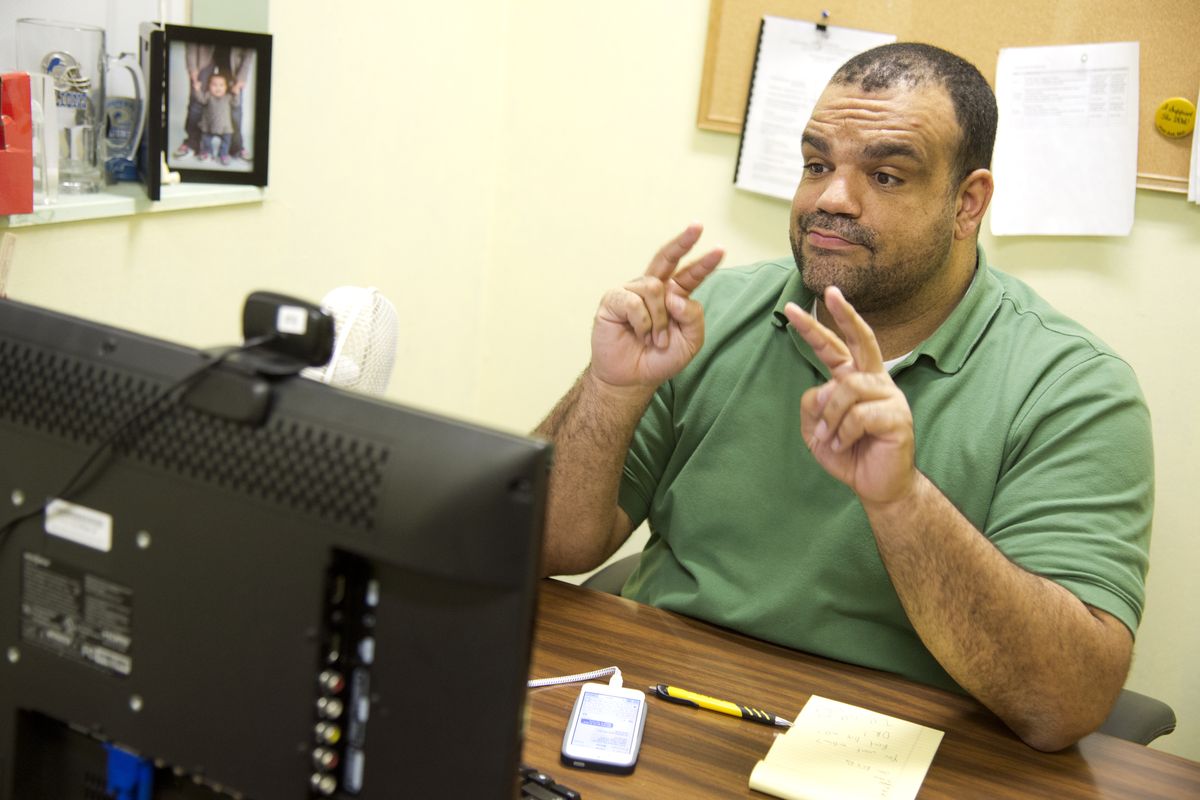Technology helps deaf people use sign language to communicate for calls

Dennis Matthews, 38, uses his hands to talk. He’s deaf and speaks American Sign Language, even during phone calls.
Thanks to Video Relay Service, Matthews can use his primary language to communicate with hearing people over the phone. All he needs is a monitor, TV, or video-capable mobile device and a high speed Internet connection.
When placing or receiving a call, Matthews is connected via video to an ASL interpreter who translates the conversation to both parties, signing over the video stream to Matthews and talking over the phone to the hearing person.
“With VRS I’m able to express in my native language. I can communicate clearly and comfortably,” said Mathews via a telephone interview using the service. “This allows me to communicate the same way as hearing people. There is no restriction.”
The middle point in the relay is an interpreting center staffed with ASL interpreters, like the one Sorenson Communications opened in Spokane Valley in December 2013.
Founded in 2003 around the advent of video relay technology, Sorenson Communications now has more than 120 interpreting centers and employs more than 5,000 ASL interpreters nationally, said spokeswoman Ann Bardsley, though she declined to disclose how many work at the Spokane center.
“VRS has revolutionized communication for deaf people. It’s accessible, real time. They don’t have to go in person or write a note. They don’t have to go to the doctor’s office to set up an appointment. They can set up an appointment like we do, over the phone,” Bardsley said.
They also don’t have to use the older TTY or TTD technology, which users say is cumbersome, slower and doesn’t allow ASL speakers to communicate in their primary language.
Sorenson vice president of community relations Ron Burdett recalled using the TTY machines for telephone calls back in the early ’70s. “They were huge. They shook,” he explained through an ASL interpreter.
He described how his landlord asked him to move to the first floor because the hearing people in his apartment complex were fed up with the noise it created. And though the machine helped him communicate, the process was slow.
“I’m a skilled typist. Hearing people would hang up on me all the time it was so slow,” he said, adding that VRS is also preferable to modern forms of written communication like text messaging and email because those require English.
“My English is pretty good but my first language is ASL,” said Burdett, noting most people who are deaf have a written English proficiency that’s between fifth and seventh grade.
“Texting is so slow. You still have to stay with English. You’re missing words. With video phone it’s our natural language so it’s richer and deeper,” he said. “The video phone changed everyone’s lives. The speed of communication is equal. It makes communication more enjoyable for both sides.”
The next step, said Burdett, is to continue to improve Internet video quality because the visual nature of ASL depends on a good video feed with high resolution that isn’t impaired by pixilation or speed-related interruptions.
Users must have a high speed Internet connection and video-capable device, such as a television, smart phone or laptop computer, but Bardsley said the company provides the rest, including setup, if needed.
Federally funded through FCC telecommunication fees, Sorenson Communications provides the service at no cost to users, which Bardsley said meets the American with Disabilities Act of 1990 mandate for functionally equivalent communications for deaf people.
For the hearing person making or receiving a call it’s like any other call but they’re talking to an interpreter in one of Sorenson’s many centers.
Burdett said the company is growing as more hearing people make calls to ASL speakers who use the service.
“Last week my (physical therapist) called me. I have been doing exercises and she explained them to me,” he said. “That part is growing so much. … With the hearing side there are more and more calls through an interpreter.”
To meet the increased call volume and keep wait times under 30 seconds, Bardsley said the company opens new centers like the one in Spokane Valley, rather than expand existing centers, because they don’t want to deplete access to interpreters in the community.
“It provides meaningful ASL work for interpreters with flexible schedules so they can still meet the demands of the community,” she said.
Spokane center manager Bronwynn Shew added that the training and experience gained while working at the interpreting center has an added benefit.
“It raises the skill level of the interpreters,” she said. “Here the interpreters are exposed to people using language from one end of the nation to the other.”
Depending on the time of day, calls vary from business calls and appointment scheduling to conversations between family and friends.
Since Sorenson set up shop in Spokane, Matthews said it has had a big impact locally.
“There are fewer interpreters in the community but the quality of interpreter increases at the same time,” he said. “When I get an interpreter their sign skills have improved greatly. I appreciate that.”